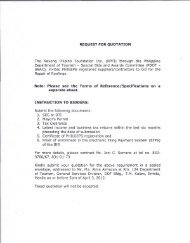regulatory impact assessment (ria) guidelines - It's More Fun in the ...
regulatory impact assessment (ria) guidelines - It's More Fun in the ...
regulatory impact assessment (ria) guidelines - It's More Fun in the ...
Create successful ePaper yourself
Turn your PDF publications into a flip-book with our unique Google optimized e-Paper software.
PHILIPPINES - REGULATORY IMPACT ASSESSMENT (RIA) GUIDELINES<br />
DRAFT – FOR DISCUSSION AND FINALISATION<br />
3. STEPS IN THE RIA PROCESS<br />
4.1 Step 1: Determ<strong>in</strong><strong>in</strong>g that <strong>the</strong> Regulation is Required<br />
It is critical to establish what is <strong>the</strong> problem/s, and <strong>the</strong> significance and risks that arise from <strong>the</strong> problem. For example, <strong>the</strong> problem/s may be<br />
related to:<br />
• Public health and safety<br />
• Environmental protection and conservation<br />
• Free market competition and equitable allocation of resources<br />
• Reliable <strong>in</strong>formation and statistics for policy and strategic development<br />
• International agreements (eg., ASEAN and WTO)<br />
In def<strong>in</strong><strong>in</strong>g <strong>the</strong> problem, identify <strong>the</strong> issues that need address<strong>in</strong>g, causes, current effects, who is affected and <strong>the</strong> risks and outcomes likely to<br />
result if no action is taken.<br />
Also identify any exist<strong>in</strong>g regulations related to <strong>the</strong> problem/s and why <strong>the</strong>y are not address<strong>in</strong>g <strong>the</strong> problem/s.<br />
In def<strong>in</strong><strong>in</strong>g <strong>the</strong> objective <strong>in</strong> tak<strong>in</strong>g government action, it is important that <strong>the</strong> objective/s is expressed <strong>in</strong> terms of what is to be achieved<br />
(outcomes and outputs) ra<strong>the</strong>r than how <strong>the</strong> objective is to be achieved. Any constra<strong>in</strong>ts on <strong>the</strong> objectives should be identified.<br />
In identify<strong>in</strong>g possible options to address <strong>the</strong> problem, both non-<strong>regulatory</strong> and <strong>regulatory</strong> approaches should be considered. Non-<strong>regulatory</strong><br />
options <strong>in</strong>clude approaches such as simply provid<strong>in</strong>g <strong>in</strong>formation, public awareness campaigns and self-regulation (eg., by <strong>in</strong>dustry groups).<br />
Regulatory options <strong>in</strong>clude revis<strong>in</strong>g or remov<strong>in</strong>g exist<strong>in</strong>g regulation that may be caus<strong>in</strong>g <strong>the</strong> problem. Options to consider <strong>in</strong> address<strong>in</strong>g <strong>the</strong><br />
problem <strong>in</strong>clude <strong>the</strong> current level of regulation <strong>in</strong>clud<strong>in</strong>g no regulation. The approp<strong>ria</strong>te form of regulation to apply will vary depend<strong>in</strong>g upon<br />
<strong>the</strong> problem be<strong>in</strong>g addressed.<br />
In assess<strong>in</strong>g <strong>the</strong> different options, it is useful to consider any budget or time constra<strong>in</strong>ts <strong>in</strong> address<strong>in</strong>g <strong>the</strong> problem, consistency with o<strong>the</strong>r<br />
regulations, and feedback and comments from relevant stakeholders.<br />
If regulation is not required, <strong>the</strong>n <strong>the</strong>re is no fur<strong>the</strong>r RIA system requirement.<br />
Version 4.0 23 July 2012 DRAFT Page 15/24
















